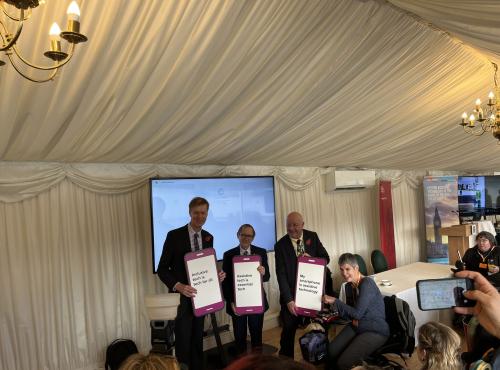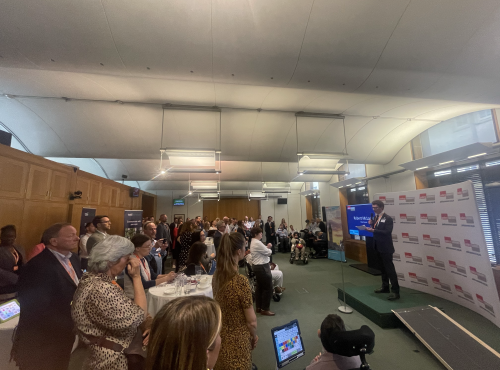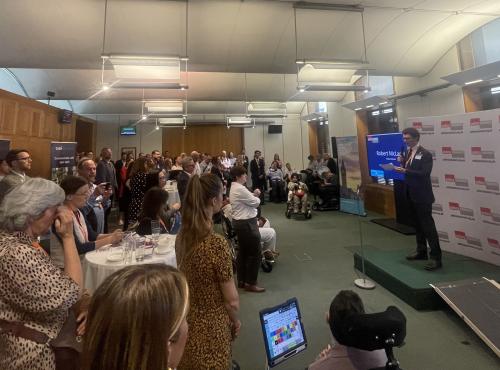Remote working and disabled employees - How a pandemic brought a long-standing issue to the forefront of the conversation
The outbreak of Covid-19 has wrought disruption on a massive scale, with organisations across the country scrambling to keep their businesses operational while ensuring the safety of their staff. Unsurprisingly, many have invested in technological solutions to enable remote working and virtual meetings. In the past, remote working has been a valuable tool for many: start-ups avoiding expensive office spaces, parents and those with caring responsibilities, and many disabled people. But now that millions of us are experiencing physical limitations, what can we learn from the past, how is this affecting disabled people now, and what legacy might this crisis have for digital inclusion in the long term?
Disabled employees have benefited from remote working for a variety of reasons - travel is often disproportionately difficult for disabled people, and office environments themselves can be disabling. People with visual impairments who rely on screen readers may be unable to access information properly with the noise of a typical open-plan office, while neurodiverse employees may struggle to focus in an environment they have little control over. Jane Hatton, the founder of EvenBreak (where every member of staff has a disability or health condition) explains, “We all work remotely, from home…[which] means we can offer a totally flexible working environment. For example, if someone has a condition such as ME, which means they need to work in short bursts and then rest, working from home makes that totally doable.”
At the same time, the rapid transition to remote working can be a significant challenge for disabled and non-disabled people alike - from getting to grips with new technologies to balancing work and childcare and protecting one’s mental health in a period of social distancing. If we think in terms of the social model of disability, which identifies disability with the barriers that disabled people face in employment and broader society, then we can understand the current crisis as effectively disabling millions of workers across the UK. Eileen Hopkins, Executive Director of Ai-Media, points out that, “COVID-19 is to some extent levelling the playing field between disabled and non-disabled employees, as workers must find a way of accessing content remotely, attending meetings and having their voice heard virtually. Again digital solutions come to the fore and provide a way of keeping business going.”
Since the outbreak of COVID-19, many disabled people have taken to social media to express their frustration at how employers who had previously denied them the reasonable adjustment of working from home are now making it a priority for all of their staff. Angela Matthews, of the Business Disability Forum, shares how in the past their advice team received calls from managers reporting a reluctance from their wider organisation to let staff work from home as, “they feel it will be harder to ‘keep an eye’ on people...we do see the perception that working from home is sometimes used as something of a ‘reward’ for high performing and ‘trustworthy’ employees.” Since the outbreak, however, they are receiving many more calls from employers keen to understand how to support their disabled staff working at home.
Although working from home can be a positive workplace adjustment for some disabled people, this is not universally true, and it is important to acknowledge the unique challenges disabled people forced to work from home may be experiencing. For example, many people may not have a workspace that supports their physical needs, and so are experiencing extra strain on their body. Many disabled people use a range of assistive technologies, and these may only be available on their work computers, not their devices at home. Even if an employee does have that technology at home, if their company rolls out a new virtual collaboration software to all staff, the training resources or the programme itself may not be compatible with screen readers, creating a huge barrier for visually impaired or dyslexic employees. Some staff who rely on Access to Work may need different adjustments, such as access to live captioning instead of BSL interpreters. Robin Christopherson MBE, Head of Digital Inclusion at AbilityNet, has been directing concerned employers and staff to Clear Talents - a free, online resource which helps identify barriers and provide clear guidance on reasonable adjustments for all protected characteristics under the Equality Act. Clear Talents has recently been updated to take into consideration issues any employee may be experiencing as a result of the ongoing crisis.
The decisions employers make now have the potential to affect their disabled staff for years. Robin reflects how, “the necessity to make rapid decisions and implement new systems to help people work from home, such as collaborative working and online meeting solutions, without employers taking due consideration of accessibility will definitely disadvantage people with a disability now during the crisis and in all likelihood for years to come. As remote working becomes the norm, it is my hope that employers make the right decisions and prioritise inclusion regardless of how rapidly they’re having to put these new solutions in place.” There is also hope for a shift in attitudes toward disability and technology. Louise Morpeth, CEO of Brain in Hand, says, “the current crisis is exposing the amazing potential of inclusive and assistive technologies that help provide remote support for those who need it. As millions of people around the UK experience physical restrictions and increased anxiety, we hope there will be more empathy and understanding for those who struggle with these issues on a daily basis, and an openness of the part of services to re-think their view of assistive technologies.”
Since the beginning of the outbreak, it has been heartening to witness so much good will, creative collaboration, and flexibility from businesses as they navigate the current state of affairs. While it remains to be seen what the lasting effects of Covid-19 will be, there is an opportunity now for senior leaders to make decisions that prioritise inclusivity and help build accessibility into their organisations for years to come.



